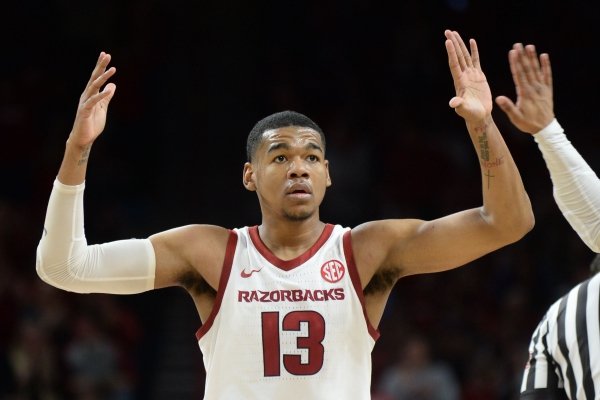FAYETTEVILLE — For the better part of Arkansas' three SEC games, Mason Jones has been the Razorbacks' most consistently aggressive guard.
Jones' first league game - at Texas A&M - didn't begin the way he'd hoped, missing his first seven 3-point attempts, but it didn't alter his mindset. He kept shooting, and by game's end he hit three of the four biggest shots of the night and helped the Razorbacks escape College Station with a much-needed road win.
The sophomore's game in the final five minutes against the Aggies carried over into last week's home games against Florida and LSU as well. Wednesday, in the worst offensive performance in Bud Walton Arena under Mike Anderson, Jones was the lone bright spot, scoring a career-high 30 points on 7/13 from the floor and 12/13 at the free throw line.
And Saturday, he and forward Daniel Gafford combined for 54 of Arkansas' 88 points in an overtime loss to the Tigers. Jones, again, hurt LSU off the bounce and at the line, where he hit 4/5 shots inside the arc and 8/9 free throws. In January, Jones is averaging a team-high 20.3 points per game and shooting 47 percent all the while playing the second-most minutes on the team (32) behind Jalen Harris (34.3).
"I think Mason’s starting to figure it out," Anderson said Monday. "They’ve been guarding him really hard. They scouted these guys. They were guarding him really hard. With most good players, they figure out how to maximize what teams are doing to them and, if you notice, he’s getting to the free throw line. That obviously continues the scoring that we need on our basketball team.
"I think he’s moving without the ball, cutting to the hole and getting layups."
Jones is 7/9 over Arkansas' last two games inside the arc since launching 11 3-pointers at Texas A&M. The losses to Florida and LSU were showcases for Jones attacking the rim - something Jones' backcourt teammates have seemingly shied away from of late.
Since Texas A&M, Harris, a 14 percent 3-point shooter on the season, has taken seven 3s and only five shots inside the arc. Isaiah Joe, meanwhile, is two of his last 10 from 3 and shooting 29 percent from distance in SEC play. Jones, to his credit, has been much more assertive and picked up the slack offensively, turning in his best scoring nights of the season in back-to-back games.
"We're not going to be a team that's just going to jack up 3s and settle," Anderson said. "Even when you think about the Florida game, half of our shots were 3-point shots and that's not who we are. We are an attacking team, and when you attack, or start inside-out, when you've got a guy the size of Daniel, and he's not a black hole, he makes great passes out of the post.
"But if you start understanding you play to win and you don't just play, without a doubt (Jones) hasn't shot many free throws, so now all of a sudden he's shooting free throws and he's doing more than just standing on the perimeter and letting it fly."
Slightly inside the top 100 in the country this season in offensive efficiency, per KenPom, Arkansas has been fairly average on that end this season. Over the last three games, the Razorbacks, while still not operating at an all-too-impressive rate, has been a markedly different team with Jones off the floor. Arkansas' offense is averaging 1.02 points per possession over Jones' 162 possessions in SEC play, and .79 PPP over the 58 he's out of the lineup.
Jones is also a beneficiary of Arkansas' uptempo style, getting lost in transition for open 3s and easy scores at or around the rim. Anderson believes Jones will continue to be a threat when the Razorbacks push the pace.
"He’s learning. He’s learning, but the one thing I always want them to understand is it’s inside-out," Anderson said. "The more we start attacking the basket, getting the ball to Daniel, I think it opens it up for (Jones). I think that is what’s taking place."

